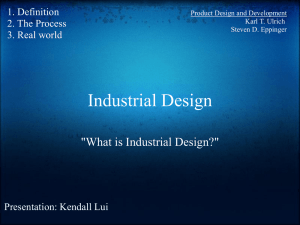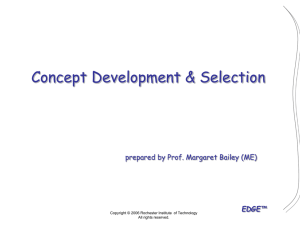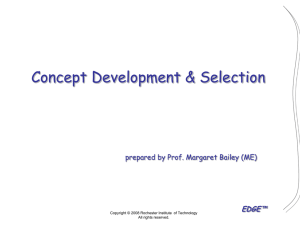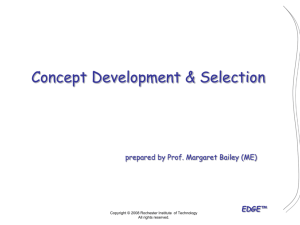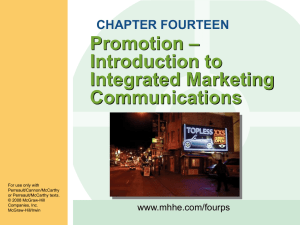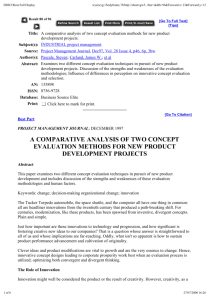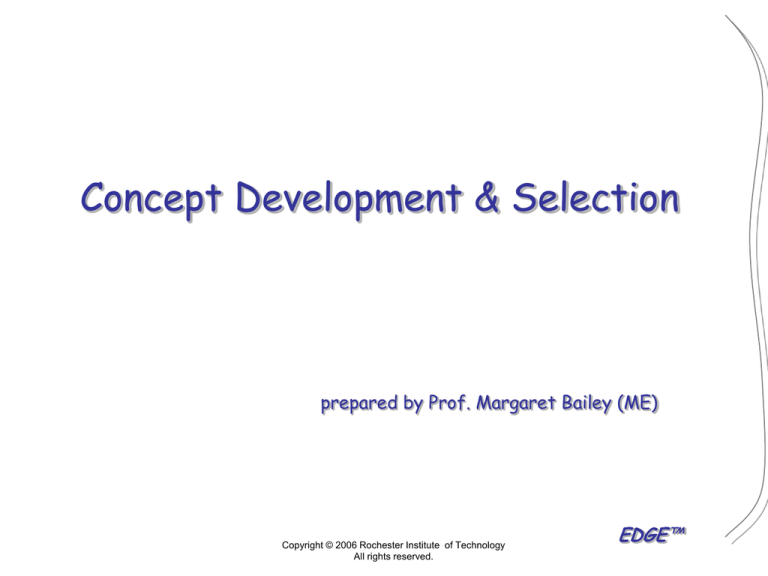
Concept Development & Selection
prepared by Prof. Margaret Bailey (ME)
Copyright © 2006 Rochester Institute of Technology
All rights reserved.
EDGE™
Today’s Workshop Overview
• 10am –11:30AM Interactive Exercise on
Concept Development & Selection
• 2 - 3:30 PM
Concept Development & Selection
on Team Project
• 3:30 – 4 PM
Create Summary of Workshop
Activities
• By 4:30 PM
Review Team Concept
Development and Selection
Activities with Guide
EDGE™
Session Overview
• Introduce Concept Development &
Selection Process
• Explore Two-Stage Methodology
• Demonstrate Above Steps on Example
• Discuss Common Dysfunctions Associated
with this Phase
• Apply Concept Development & Selection
Process to Team SD1 Project
EDGE™
Concept Development & Selection
Session Learning Objectives
1. Understand concept selection matrix commonly used decision tool in product
development
2. Reinforce importance of concept selection
within product development process
3. Explore the application of a selection matrix
method for selecting & developing product
concepts – can be applied to sub-systems as
well.
EDGE™
Concept Selection Example:
Reusable Syringe
Karl T. Ulrich and Steven D. Eppinger, 2004, Product Design and
Development, Exhibit 7-1, Chapter 7, 3rd Edition, Irwin McGraw-Hill
EDGE™
Concept Selection Example:
Reusable Syringe
• Design an improved, reusable syringe with
precise dosage control for outpatient use.
– Current product was too costly and inaccurate
• Seven criteria identified based on customer
needs
– Ease of handling, use and manufacture
– Readability of dose settings and accuracy
– Durability and portability
• Seven overall product concepts proposed
(Exhibit 7-3)
EDGE™
Concept Development & Selection Process
Mission
Statement
Identify
Customer
Needs
Establish
Target
Specifications
Generate
Product
Concepts
Select
Product
Concept(s)
Test
Product
Concept(s)
Set
Final
Specifications
Plan
Downstream
Development
Development
Plan
Perform Economic Analysis
Benchmark Competitive Products
Build and Test Models and Prototypes
These activities can occur
throughout the design
process!
Karl T. Ulrich and Steven D. Eppinger, 2004, Product Design and
Development, Exhibit 7-2, Chapter 7, 3rd Edition, Irwin McGraw-Hill
EDGE™
Concept Development &
Selection Process
Concepts
Scoring
Stage
Selection Criteria
Screening
Stage
Concept Ratings
Winning Concept(s)
Goal: The goal is not to select the best
concept but to develop the best concept
by combining and/or refining
EDGE™
Concept Development & Selection
Funnel
concept gener ation
concept screeni ng
concept scor ing
concept testi ng
Karl T. Ulrich and Steven D. Eppinger, 2004, Product Design and
Development, Exhibit 7-4, Chapter 7, 3rd Edition, Irwin McGraw-Hill
EDGE™
Examples of Concept Generation
Karl T. Ulrich and Steven D. Eppinger, 2004,
Product Design and Development, Exhibit 7-3,
Chapter 7, 3rd Edition, Irwin McGraw-Hill
Concepts need to be well-defined
PRIOR to concept evaluation!
(neither of these concepts made
the screening cut) EDGE™
Concept Selection Process
Screening Stage
Prepare the Matrix
Rate Concepts
Rank Concepts
Combine and Improve
Select Best Concept
Reflect on the Process
Scoring Stage
Prepare the Matrix
Rate Concepts
Rank Concepts
Combine and Improve
Select Best Concept
Reflect on the Process
EDGE™
Concept Development & Selection
Funnel
concept gener ation
concept screeni ng
concept scor ing
concept testi ng
Karl T. Ulrich and Steven D. Eppinger, 2004, Product Design and
Development, Exhibit 7-4, Chapter 7, 3rd Edition, Irwin McGraw-Hill
EDGE™
Screening Stage
• Prepare the Matrix – Pugh's
METHOD
Concepts which made the first
cut BUT more refinement
required before SCORING
process
– Criteria
– Select Reference Concept
• Rate Concepts
– Scale (+ – 0)
– Compare to Reference
Concept
• Rank Concepts
• Combine and Improve
– Remove Bad Features
– Combine Good Qualities
• Select Best Concepts
– May Be More than One
– Beware of Average Concepts
• Reflect on the Process
– Continuous Improvement
Karl T. Ulrich and Steven D. Eppinger, 2004, Product Design and
Development, Exhibit 7-5, Chapter 7, 3rd Edition, Irwin McGraw-Hill
EDGE™
Identify “Winning” Concepts
Concept A has highest net
score and no “worse than”
ratings
Karl T. Ulrich and Steven D. Eppinger, 2004, Product Design and
Development, Exhibit 7-3, Chapter 7, 3rd Edition, Irwin McGraw-Hill
EDGE™
Combine Winning Concepts
Concepts D & F were
combined to eliminate
“worse than” ratings
Karl T. Ulrich and Steven D. Eppinger, 2004, Product Design and
Development, Exhibit 7-3 and 6, Chapter 7, 3rd Edition, Irwin McGraw-Hill
EDGE™
Refine Winning Concepts
Concept G’s scored well but
ease of handling was a
problem, therefore revise!
Karl T. Ulrich and Steven D. Eppinger, 2004, Product Design and
Development, Exhibit 7-3 and 6, Chapter 7, 3rd Edition, Irwin McGraw-Hill
EDGE™
Screening Stage for SD1 Project
• NOW
– Select a sub-system (or overall product if applicable)
– Prepare the Matrix
– Begin the following as time allows
• This afternoon:
–
–
–
–
–
Rate Concepts
Rank Concepts
Combine and Improve
Select Best Concept
Reflect on the Process
EDGE™
Concept Development & Selection
Funnel
concept gener ation
concept screeni ng
concept scor ing
concept testi ng
Karl T. Ulrich and Steven D. Eppinger, 2004, Product Design and
Development, Exhibit 7-4, Chapter 7, 3rd Edition, Irwin McGraw-Hill
EDGE™
Scoring Stage
•
REFINE Pugh’s Matrix
•
Rate Concepts
•
Rank Concepts
•
Combine and Improve
•
Select Best Concepts
•
Reflect on the Process
– Criteria
– ADD Weightings
– REFINE Scale (1 - 5)
– Select “Average” Criteria for
Reference
– Compare to Reference Criteria
– Sum Weighted Scores
– Remove Bad Features
– Combine Good Qualities
– May Be More than One
– Continuous Improvement
Karl T. Ulrich and Steven D. Eppinger, 2004, Product Design and
Development, Exhibit 7-7, Chapter 7, 3rd Edition, Irwin McGraw-Hill
EDGE™
Generated from
Customer Needs
– week 1
Example: Concept Scoring
Concepts
A
(reference)
Master Cylinder
DF
E
G+
Lev er Stop
Swash Ring
Dial Screw+
Selection Criteria
Weight
Rating
Weighted
Score
Rating
Weighted
Score
Rating
Weighted
Score
Rating
Weighted
Score
Ease of Handling
5%
3
0.15
3
0.15
4
0.2
4
0.2
Ease of Use
15%
3
0.45
4
0.6
4
0.6
3
0.45
Readability of Settings
10%
2
0.2
3
0.3
5
0.5
5
0.5
Dose Metering Accuracy
25%
3
0.75
3
0.75
2
0.5
3
0.75
Durability
15%
2
0.3
5
0.75
4
0.6
3
0.45
Ease of Manufacture
20%
3
0.6
3
0.6
2
0.4
2
0.4
Portability
10%
3
0.3
3
0.3
3
0.3
3
0.3
T otal Score
Rank
Continue?
2.75
3.45
3.10
3.05
4
1
2
3
No
Develop
No
No
Need to revisit PUGH Matrix as your
team’s knowledge base expands
EDGE™
Karl T. Ulrich and Steven D. Eppinger, 2004, Product Design and
Development, Exhibit 7-7, Chapter 7, 3rd Edition, Irwin McGraw-Hill
Final Winning Concept - DF
Concept DF was selected as the winning concept HOWEVER:
Do not simply select concept was highest rating – conduct a
sensitivity study by varying weights and ratings and examine
effect on winning concept rating. Does uncertainty about a
particular value have a large impact on the winning concept?
Team could have decided to go with top two (or more) concepts.
Concepts could be prototyped and tested for customer feedback.
EDGE™
Karl T. Ulrich and Steven D. Eppinger, 2004, Product Design and
Development, Exhibit 7-6, Chapter 7, 3rd Edition, Irwin McGraw-Hill
Tips for Concept Development & Selection
• When possible, use objective rather
subjective criteria
• Useful to identify strengths of concepts that
do not make it through screening/scoring
stages – could these be incorporated on
winning concept(s)?
• Include ease of manufacture, reduced
liability, and/or cost as criteria
• Use concept development & selection process
throughout SD1 and SD2
EDGE™
Concept Development & Selection
Funnel
concept gener ation
concept screeni ng
concept scor ing
concept testi ng
Karl T. Ulrich and Steven D. Eppinger, 2004, Product Design and
Development, Exhibit 7-4, Chapter 7, 3rd Edition, Irwin McGraw-Hill
EDGE™
Test Product Concepts
Mission
Statement
Identify
Customer
Needs
Establish
Target
Specifications
Generate
Product
Concepts
Select
Product
Concept(s)
Test
Product
Concept(s)
Set
Final
Specifications
Plan
Downstream
Development
Development
Plan
Perform Economic Analysis
Benchmark Competitive Products
Build and Test Models and Prototypes
Helps in further exploring concepts…
Which concept should be pursued?
How can the concept be improved to better meet customer needs?
Should development continue?
TOOL: Survey customer response, refer to Chapter 8 for more details
Karl T. Ulrich and Steven D. Eppinger, 2004, Product Design and
Development, Exhibit 8-2, Chapter 8, 3rd Edition, Irwin McGraw-Hill
EDGE™
Practice Concept Development &
Selection on SD1 Project
• Continue Team Screening Stage and start
Scoring Stage
Screening or
Scoring Stages
Prepare/Refine the Matrix
Rate Concepts
Rank Concepts
Combine and Improve
Select Best Concept
Reflect on the Process
Sample Excel
Spreadsheet
Available for
PUGH
EDGE™
Rest of the Day….
• Start with Concepts Associated with Critical Sub-function(s)
Identified During Week 3
– Develop Pugh's Matrix for SCREENING Process
• Create Criteria, Select Reference Concept, Rate Concepts
(Scale (+ – 0)), Compare to Reference Concepts, Rank Concepts,
• Combine and Improve, Remove Bad Features, Combine Good
Qualities, Select Best Concepts
• Refer to Exhibit 7-5
– Refine Pugh's Matrix during SCORING Process
• Refine Criteria, ADD Weightings, Rate Concepts (Scale (1 - 5)),
Select “Average” Criteria for Reference, Determine Sum
Weighted Scores
• Combine and Improve, Remove Bad Features, Combine Good
Qualities, Select Best Concepts
• Refer to Exhibit 7-7
EDGE™
Next Week(s)
Review and submit following deliverables to
Team Guide during week 5 and beyond:
• Update Overall Project Plan and Schedule
• Results of Concept SCREENING Process for
all identified critical sub-functions (refer to
Exhibit 7-5)
• Progress on Concept SCORING Process for
each critical sub-functions (refer to Exhibit
7-7)
EDGE™
Week 5 Graded Item:
Concept Review - Logistics
• 30% of SD1 Grade
• In-depth meeting with Guide, Consultants,
peers, customer(s), other experts to provide
feedback
• PowerPoint presentation may help organize
discussion, however should be more like a
discussion than a formal presentation
– NOT a formal PowerPoint presentation but rather
a discussion
EDGE™
Concept Review Grading Rubric
Concept Review
Category
Concept Generation
Team:
Score
Excellent (10)
Satisfactory (8)
Barely Acceptable (6)
Unacceptable (0-5)
0
Concepts were sufficiently
developed for objective
evaluation, included
Some models/simulations still
remain incomplete, or must be
re-run. Critical work is
complete or nearly complete
Some critical analysis still
remains unfinished or
questionable
Minimal concept development,
reliance on only a few ideas
Appropriate Evaluation Criteria
0
Evaluation of Concepts
0
Concept
Improvement/Combination
0
Concepts were evaluated
Some customer criteria were
No competitive benchmarking,
against customer-oriented
not addressed in evaluation, or
Many customer needs left
and many customer needs not
criteria, as well as competing competitive benchmarking was
unaddressed in criteria
addressed in criteria
products
not done
Concepts were evaluated
Some evaluation was
objectively, using an
Final ranking not clear, much
Some evaluation was
subjective or final ranking was
appropriate datum concept and
of evaluation was subjective
subjective, or final concept
unclear, and a structured
a structured evaluation
and did not use a structured
ranking was not clear
evaluation process was not
method, and resulting in a
approach
used
clear ranking
The team clearly took
The team showed some ability
The team made minimal
advantage of the evaluation
to use the evaluation process
efforts to improve on original
process to improve or combine to improve on original concepts
concepts during evaluation
existing concepts or to uncover
or combine one or more
process
some fixable weaknesses
concepts
All preliminary analysis
required for evaluation has
been done - based on
engineering estimates and
input from customer
Preliminary Analysis (if
applicable)
Estimates for preliminary
analysis were unrealistic or
unfounded
Preliminary analysis was done
incorrectly
The team did not take
advantage of any opportunities
to use concept evaluation to
improve existing ideas
Preliminary analysis could
have been done to help with
evaluation, but was not
0
EDGE™
Week 5 Graded Item:
Concept Review - Content
• Discuss
– Concepts with enough detail to reasonably complete a
concept evaluation
– Include concepts, details, and evaluation process
• Identify high-risk areas of the design, and enough
modeling and/or simulation (computer-based or
physical mock-up) to demonstrate that the project
can be successful
– may include features such as new technology, previously
untested technology, long-lead time or prohibitively
expensive components
• Additional specific requirements should be agreed on
with Guide
• TEAM Goal: receive useful feedback from reviewers
EDGE™

